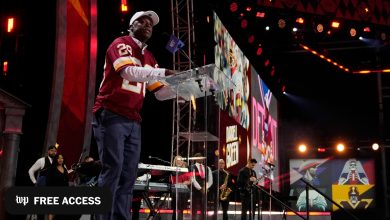Breaking down the NFL’s new kickoff

Requirements: The kick must land between the goal line and the 20-yard line. To encourage returns, kicks into the end zone will be punished severely; the ball will be spotted at the 30-yard line. Kicks that hit in the landing zone, roll into the end zone and are downed there will be spotted at the 20-yard line. Kicks short of the landing zone will be spotted, like kicks out of bounds, at the 40-yard line. A kick that falls in the landing zone must be returned.
Action: The prospective tacklers on the kicking team and the blockers lined up in the setup zone for the receiving team cannot move until a returner touches the ball or it hits the ground. Once a returner catches the ball, the new kickoff model is designed to resemble a play from the line of scrimmage.
Return rate: Dallas Cowboys special teams coordinator John Fassel, one of the designers of the new kickoff format, said the league projects that 55 to 60 percent of kickoffs will be returned.
That projection would have been 85 to 90 percent, Fassel said, if the rule had called for the ball to be spotted at the 35-yard line for a touchback, creating a greater disincentive for the kicking team to send the ball into the end zone. The competition committee tweaked the proposal Sunday to make it the 30-yard line instead.
After the new rule is in effect for one season, the league could move the spot to the 35-yard line to further increase returns.
Onside kicks: Onside kicks will only be allowed during the fourth quarter, and only by the trailing team. A team must declare its intention, and the setup will revert to the traditional kickoff alignment.
Surprise onside kicks are not possible under the new rule. But there were only two leaguewide last season.
The Philadelphia Eagles proposed a fourth-and-20 alternative to the onside kick that would have allowed a team to retain possession of the ball by converting a fourth-and-20 play from its 20-yard line. The owners did not approve that proposal. Rich McKay, the chief executive of the Atlanta Falcons and the chairman of the competition committee, said he would like to see the fourth-and-20 proposal revisited next year.
Field position: The average starting field position for the receiving team is projected to be around the 28- or 29-yard line, according to New Orleans Saints special teams coordinator Darren Rizzi, who participated in designing the new rule. That compares to the 25.2-yard line last season.
Kicking stick: If the ball blows off the tee twice on a windy day, the kicker is permitted to use a kicking stick to hold the ball in place. One of the officials would be in charge of picking up the kicking stick immediately after the ball is kicked so that it would not be on the field during the return.
Penalty enforcement: Any penalty on a touchdown would be assessed on the conversion and could not carry over to the kickoff. A penalty on the conversion could carry over to the kickoff, in which case only the spot of the kick would change. The setup zone and landing zone would remain the same.
Duration: The new rule was proposed and ratified for one year. The competition committee, league and owners will have to reexamine the issue next offseason.
Roster ramifications: Kick returners are back in demand. The Pittsburgh Steelers agreed to a reported two-year, $6 million deal with Cordarrelle Patterson just hours after the new format was ratified. He is the NFL’s all-time leader with nine career touchdowns on kickoff returns.
Teams could reconsider the size and speed of the players they put on the field for their kickoff coverage and kickoff return units. There could be a push for teams to be given an additional roster spot or an additional slot for an active player on game days, given that the number of injuries occurring on kickoffs is likely to increase. Even if the injury rate is reduced to being comparable to that of a play from scrimmage, as intended, the expected increase in the number of live plays (with far more kickoffs being returned) probably will lead to more injuries.
Apsny News English



